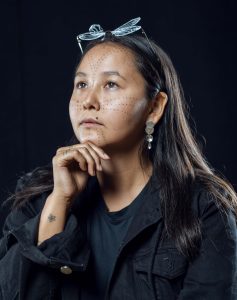
Inuk filmmaker asinnajaq uitaalutuq (BFA 2015) was born in Kuujjuaq, Quebec, and grew up with a filmmaker father, the documentarian Jobie Weetaluktuk (Qallunajatut, Kakkalaakkuvik), but he never pushed her toward his vocation. “My dad is all about letting you listen to yourself and your heart and finding your path,” she says from her home base, Montreal. But they bonded over their love of photographing nature and asinnajaq ultimately found herself at NSCAD pursuing an MFA in film.
Her accomplishments have stacked up quickly: She was on the curatorial team for the Canadian pavilion at the 58th Venice Biennale, and in 2020 was one of 25 winners of the Sobey Art Award—$25,000 that helped her survive the pandemic. Her 14-minute short film Three Thousand (2017), produced by the National Film Board, was pieced together from the NFB’s archives of Inuit life, closing with vivid animation imagining landscapes of futuristic igloos, which is why she calls it “a sci-fi documentary.” As part of the NSCAD Film Festival, asinnajaq will speak to fellow filmmaker Raghed Charabaty on April 25. Register here for the stream.
What were your perceptions of Halifax and NSCAD?
I love that the film academy had its own building—it was a part of the larger school but kind of had its own feeling. It was small classes, that was important to me, so I could really get to know my classmates and teachers. I loved living in Halifax—it was different then, of course. Less buildings. It was a really beautiful size where there was a lot to explore but you knew what was going on. Manageable. My classmates are what made it so amazing—in my cohort we really got to know each other, and one of the best things was we always shared films. A big part of my film education came from that—I really got into the French New Wave and arthouse films.
How was it studying film, a medium you love, within an academic framework?
A lot of different knowledge fits together. My art philosophy is “don’t know anything about something and then you can make something great.” Or else really, really know what it is so you know the rules you can play with. I really loved the education I had in film—it gives me this approach of something I feel like I know I can play with, and I can see how I can be a part of it.
The other thing I really liked about going to NSCAD specifically is that I could learn and touch all the different parts of filmmaking—we learned how to be the producer, the director, the camera operator, the writer, the production manager. It gives me so much confidence in my filmmaking.
Is it true you went through the entire NFB archive to find the footage for Three Thousand?
I went through the archive twice. The first time I was trying to look for something and basically I felt like that was a bad approach—it was me trying to see what I wanted to see, rather than listen for the story that already existed in it. When I look back on it everything is a decision: I thought there should be a balance between landscape, animals, people. Activities, family. It was partly what’s in the archive and finding a way to tell that story and also about trying to tell a whole story about what life was, and is. It’s a balance about sharing things that are joyful and difficult.
